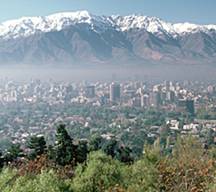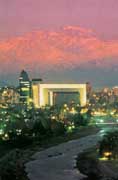About Chile & other relevant information
International Workshop jointly organized by:
ESO/Chile, FONDAP-Chile and Universidad de Chile
Physics of Active Galactic Nuclei at all scales
at ESO/Santiago Headquarters, Chile - December 3 to 6, 2003
About Chile & other relevant information

Chile in a Nutshell:
Many things can be said about Chile, but one thing is for sure, its 4.300km shoreline does provide a generous diversity of landscapes: from the arid Atacama desert in the north; Mediterranean central valley, to the mountainous but temperate lakes district and Patagonia´s spectacular alpine glaciers and fjords. The magnificent and massive Andes Mountains crests are almost always within sight even from the sunny, yet cold Pacific beaches. Chile´s people are friendly and hospitable to foreigners, its tremendous geographic diversity and surprising cultural variety have made it an important destination to thousands of travelers. It is considered the most dynamic economy of South America.
At the Airport:
Immigration and custom formalities are generally straightforward. However, citizens of the following countries should be aware that, upon arrival in Chile, they will have to pay a "reciprocity tax": Australia (for which the amount of the tax is US $ 50), Canada (US $ 75), Mexico (US $ 35), USA (US $ 100). Payment must be made, IN CASH ONLY (US DOLLARS), at a special counter located before immigration. Please make sure that you come in with a sufficient amount of cash in US dollars.
There are several ways to get from the airport to your hotel. Tickets for all the
options below are available at counters either inside baggage claim, or in the
arrivals section, where there is also a cash machine.
The most expensive option is to take an official taxi (~13000 CHP, you can also pay in US$). We don't recommend an unofficial taxi, unless you can bargain in Spanish.
A cheaper option is to take a transfer van (TransVIP) which will take several people going to the same area of the city (~7000 CHP).
Cheapest of all is to take an airport bus (1000 CHP) to downtown Santiago, and then
a city bus (300 CHP) from downtown to Vitacura. We only recommend the
last option if you are familiar with Santiago buses!
About Santiago: (link to touring Santiago and surroundings)
South of the Aconcagua begins the fertile heartland of the central valley which contains the city of Santiago, and a third of the country´s population (5.1 million inhabitants). This area enjoys a delightful Mediterranean climate with maximum temperatures averaging 28°C in January (summer) to 10°C July (winter). A contrasting city to say the least, old colonial buildings downtown, street vendors, and glowing skyscrapers dominate the landscape. For general information on Chile: www.gochile.clWeather:
Spring days in Santiago are delightfully warm, dry and generally breezy during mid-morning, it virtually never rains and average temperatures during the day in October can reach 24°C, however, at night, temperatures can drop to 17°C, therefore a light cardigan might be necessary for the evenings. For more information:www.cnn.com
Local Transport:
As with most Metropolis, Santiago has several transportation systems, however some are safer and much more effective than others. We recommend using the Metro. The Santiago Metro is clean, expeditious, safe and runs from 6:30 am to 11:30 pm.
If coming to ESO from downtown, get off at "Escuela Militar" station. Find a taxi cab that will take to ESO (Alonso de Córdova 3107) the ride should not take more than 15 minutes (unless caught in the rush-hour traffic, typically between 6:00 pm and 8:30 pm) and the fare should not exceed $2.000 pesos (about US$4).
workshop email: agn2003@sc.eso.org




